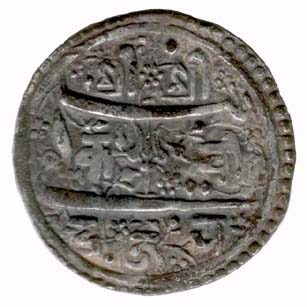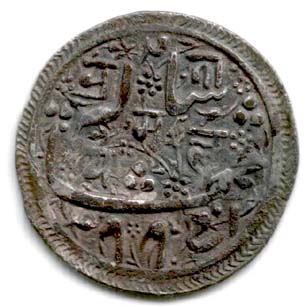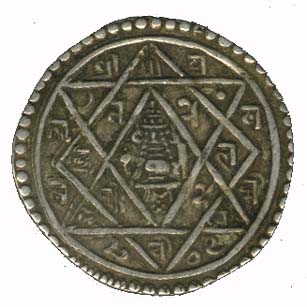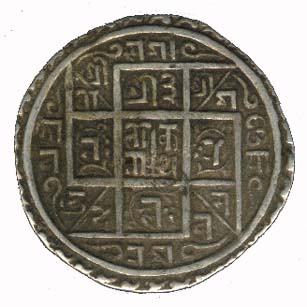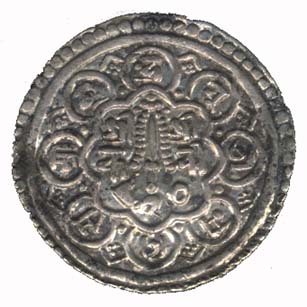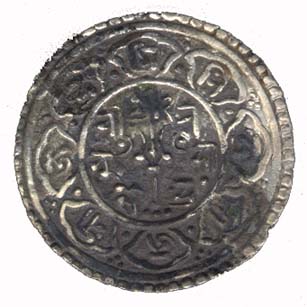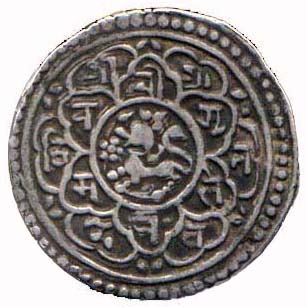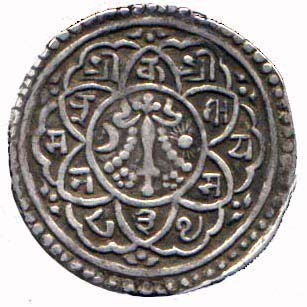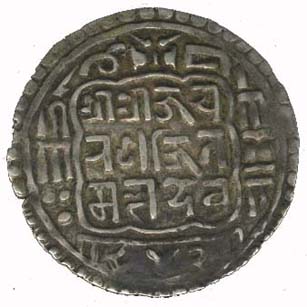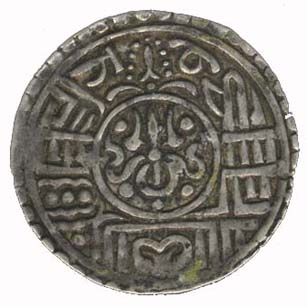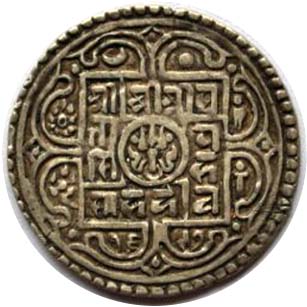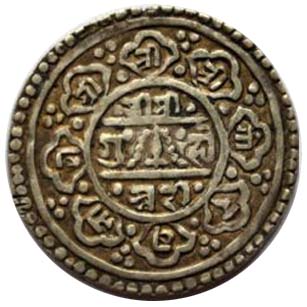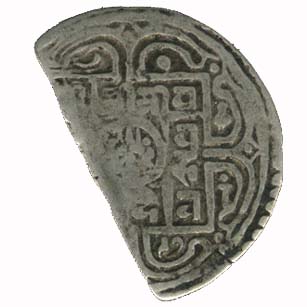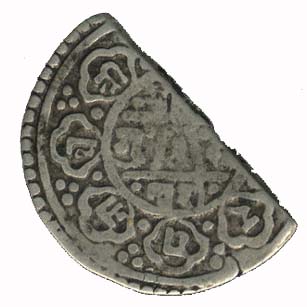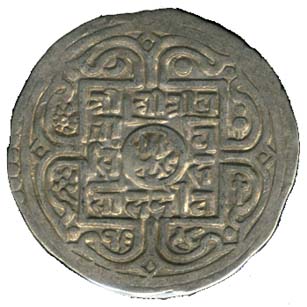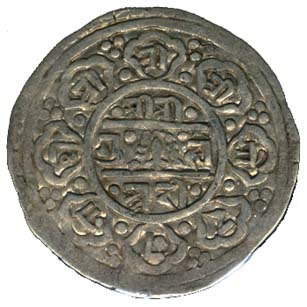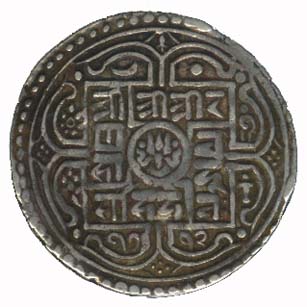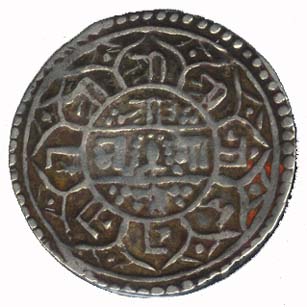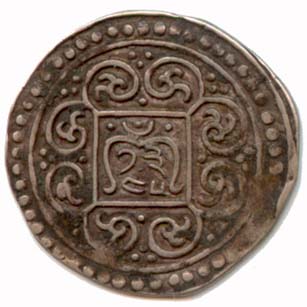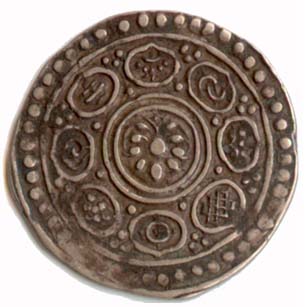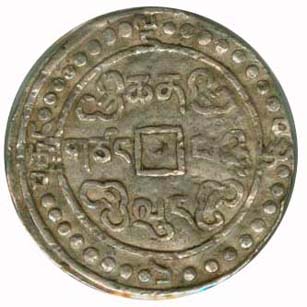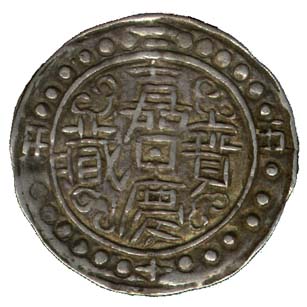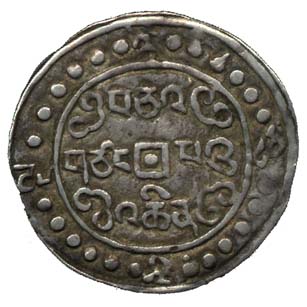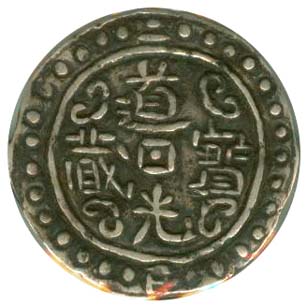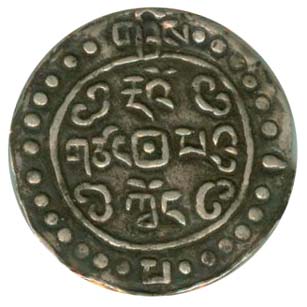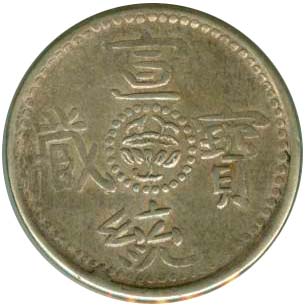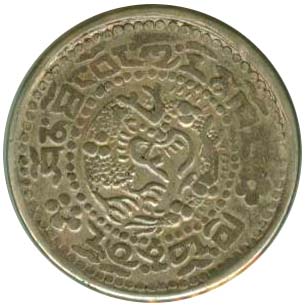|
|
Tibetan Coinage INepalese and
Tibetan Coinage during the Qing Dynasty
Recently, I have received several e-mails quarried in the Tibetan coinage. I attribute a couple hundred Tibetan coins, they are all inexpensive.
I have a special fondness for the fabric of the Tibetan coins, especially the 8 lucky symbols of Buddhism on the reverse, though I am not a Buddhist. I think these precious symbols must have their esoteric meaning. Some collectors even believe that owning such a coin brings the owner good luck, I really hope this is true, as I get a few hundred Tibetan coins.
Buddhism is extremely complex to me, I don't want to gain a further understanding of it. The eight lucky symbols are easily to be found on every Tibetion coin.
Symbol of Eight Good Omens
The normal order of the eight auspicious objects used in religious rites in Lamaism. They are :
The magic umbrella
[rin chen gdugs]
Gold fish
[gser nya]
Magic bottle
[gter cher bum pa]
Holy lotus
[pad ma]
White snail of right spiral shell
[dung dkar gyas vkhyil]
Diamond knot
[dpal bevu]
Satin cylinder
[chos kyi rgyal mthsan]
Gold wheel
[vkhor lo]
Actually, I find difficulty to verify the dates of the coins. I can't read the Tibetan script, I rely much on both the Chinese and Western references.
Tibet was isolated by the world as it located between the famous Himalayan and Kunlum mountains, southwestern part of China and or north of Nepal and India. Tibet is completely encircled by mountains. To the West, Tibet has represented a forbidden land of strangers and or an exotic region of mystery.
The Tibetans accepted the Mongols as overlords in about 1207. After the death of the Genghis Khan in 1227. Tibetan officials had stopped sending the prescribed tribute to Mongols. The third son of Genghis Khan, O"gedei (窩闊台), the successor designate of Great Khan who sent a Mongolia troop into Tibet under the command of Generals Dhordha (多達那波) and Lichi in 1239, Tibetan officials surrendered, and negotiated a treaty, so that they could go on their positions in the Tibetan government. Since then Mongols or Yuan Dynasty sent garrison troops to Tibet and set up post stations to open up transportation and communications between Tatu (now Peking) and Tibet. Tibet became subject to the Yuan Dynasty, whose central administration, passed the power to the Sakya for the overlordship of Tibet.
During the middle of 17th century, the Mongolian prince, Gorshi Khan helped the 5th Dalai Lama became the ruler of the Tibet and established the Ganden Podrang administration which was recognized by the Qing Dynasty. From that time, the Qing government established its representative in Lhasa in order to strengthen its control over Tibet. The Ganden Podrang's Administration governed Tiber until 1959. Tibet is now under the Tibetan Autonomous Region of China.
Some Chinese scholars believed the use of silver coins in Tibet could be traced back to 1632, the fifth year of the Chung Chon reign of the Ming Dynasty. But it is hardly to prove it with any coin picture or rubbing in the collecting circle.
In the middle of 16th century, the coins used in Tibet had been imported from Nepal.
Mr. N G Rhodes ( author of the book - The Coinage of Nepal ) believed that the popularity of Nepal eight-petalled coins in Tibet was perhaps partly because of the auspicious Buddhist lucky emblems, and or because of the fact that the petals could act as guidelines for cutting the mohar into factions of 1/3, 1/2 or 2/3, depending on how many petals remained on the cut piece.
If the coins were cut with a straight line leaving five petals on one part, and three petals on the other, the coin was divided by weight almost exactly in the ratio 2:1, so that the piece with five petals was worth one sho and the piece with three petals was worth five karma. Similarly the coin could be cut in half by a straight cut so that a piece with four petals was worth 7.5 karma.
The quantity of the Nepalese silver coins for Tibet often debased, but the Nepal Malla kingdoms including the Khathmandu, Bhatgaon and Patan kingdoms, exchanged their coins with the Tibetans for an equal weight in silver bullion from 1556 until 1792.
Coins of the three Nepal Malla kingdoms are not difficult to verify, because three distinctive designs were introduced on the Nepal coins, a triangle on the Bhatgaon coins, a star on the Patan coins, and curved lines on the Kathmandu coins. (The curved lines on the Kathmandu issues were borrowed from the design of the silver coins of Mughal India.) The Nepal Mohar also inscripted with name and title of the different issuing kings in Nepali. Later the three kingdoms were all overthrown in 1768 by Prithvi Narayan, the Shah reler of the Kingdom of Gorkha, west of Kathmandu. But the mohar coinage continued until a regular issue began in Tibet in 1791 with similar design of square and lotus frame.
Below is the Dating of Nepal coins from Standard catalog of World Coins:
Nepal Samvat Era (NS)
All coins of the Malla kings of Nepal are dated in the Nepal Samvat era (NS). Year 1 NS began in 881, so to arrive at the AD date add 880 to the NS date. This era was exclusive to Nepal, except for one gold coin of Prana Narayan of Cooch Behar.
Saka Era (SE)
Up until 1888AD all coins of the Gorkha Dynasty were dated in the Saka era (SE). To convert from Saka to AD take Saka date + 78 = AD date.
Normally local coinage went on sporadically in Tibit, it was because silver for coinage was imported from India and Central district of China in the ancient time. Sycee bullion from the Central China in different sizes and shapes had been as monetary commodity in Tibet for centuries.
I remember a Western reference mentioned that during the war between the Tartars and the Chinese in 1719 or 1720, every Chinese soldier had received advance pay for five years in bits of silver of various sizes. I hardly guess the amount of silver had imported to Tibet at that time.
One of the Chinese reference states that there were about 10000 Qing soldiers had been sent to Tibet in 1719, each soldier got a payment of 4 taels in weight of silver per month.
[Another Chinese reference '藏學研究論叢第六輯, 87頁 - Zang Xue Yan Jiu Lun Cong, page 87, ISBN7 223 00747 8/2. 46', mentioned about the Central Chinese Government had paid 10,520,000 taels in weight of silver for the Qing troop during the war (It was caused by the debased coins) between Nepal and Tibet in 1791. The amount of silver was equal to one quart of the total annual income of the Chinese Government at that time.]
I have seen some early Tangka rubbings in a Chinese reference - 'An Overview of China's Gold & Silver Coins of Past Ages - the Gold and Silver coins and Medals of Modern China'. Those Tangka rubbings in the book were believed minting in 1763 by the Regent of the Tibet government, Dican Hutuktu. The coins bear no inscriptions but motifs only which express the prayer wheel of Buddhism in Tibit.
In 1792 Qing government established a mint in Lhasa to issue silver coins for the local market until 1836. The first issue was closely modeled on the old Tibetan coins, the later one was introduced with Chinese inscription on one side [Ch'ien Lung Pao Tsang - 4 Chinese characters mean Ch'ien Lung Treasure for Tibet] and a Tibetan translation of it on the other. On the both sides of the coin were bearing an intended square hole in the middle. There were three denominations weighing 1.5, 1, and 0.5 mace. Similar Pao-Tsang coins were cast in the reigns of Chia Ch'ing, Tao Kuang and Huan Tung Emperors until the establishment of the Republic of China in 1911. All of these coins were known by the Western as Sino-Tibetan coinage.
A Chinese reference mentions about coins exquisitely minted in the first year of the K'ang Hsi reign (1661) were discovered for the first time and were not recorded in history.
(page 37, A History of Chinese currency - 16th century BC - 20th century AD)
Later I hope I can talk about my other Tibetan coins on the next page when I get more time. I find that most of my Tangkas look minting with silver, but I believe some of them are billion coins. I am surprised to find that one of the Ga-den Tangka looks minting in aluminum. Some of the coins appear to have no dates and to have been struck over a long period of time. There are many varieties of these coins. I confess in verifying the dates on the coins, more the worse, I can't even verify the coins of the different 5 mints in Tibet.
As I know that there are 5 mints have issued coins in Tibet. They are Dode; Dodpal; Mekyl; Ser-Khang and Tapchi mints. Although there are no mintmarks on the coins, an experienced collector can point out the varieties of the mints easily by reading the legend. I hope I can verify my Tangka coin soon.
Bibliography
- Hsiao Huai Yuan : The History of Tibetan Money
- Tibet Branch of the People's Bank of China: China Numismatics 1990.1 No.28
- N G Rhodes : The Gaden Tangka of Tibet, Oriental Numismatic Society 1983
- Oliver D Cresswell : Tibetan Coins by Numismatics International Publication 1977
- Dong Wenchao : An Overview of China's Gold & Silver Coins of Past Ages - the Gold and Silver coins and Medals of Modern China, ISBN: 962-531-0001-0
- A History of Chinese Currency (16th Century BC - 20th Century AD), 1983 Jointly Published by Xinhua (New China) Publishing House N.C.N. Limited M.A.O. Management Group Ltd. ISBN 962 7094 01 3
- Pang Hsin Wei : The Currency History of China, 1988. ISBN7-208-00196-0/K.47
- Chester L. Krause and Clifford Mishler Colin R. Bruce II. : Standard catalog of World Coins 1991, 18th edition.
- N G Rhodes, K. Gabrisch & C Valdettaro : The Coinage of Nepal
- 布爾努瓦:西藏的黃金和銀幣(法)中國藏學出版社 1999
- 張惠信:中國貨幣傳奇 可筑書房 1991
- 張惠信:中國貨幣圖錄 台揚出版社 1992
- 張惠信:中國貨幣史話 台揚出版社 1994
- 姜宏業:中國地方銀行史, 湖南出版社 1991
- 趙萍 續文輝:簡明西藏史 民族出版社 2000
|
